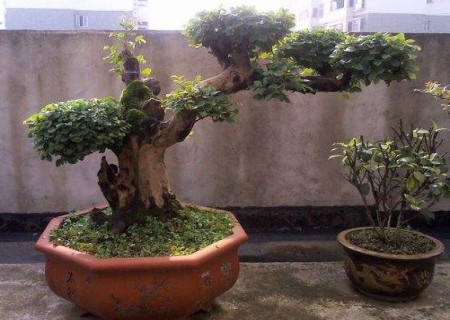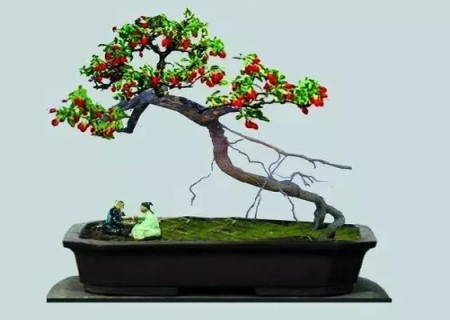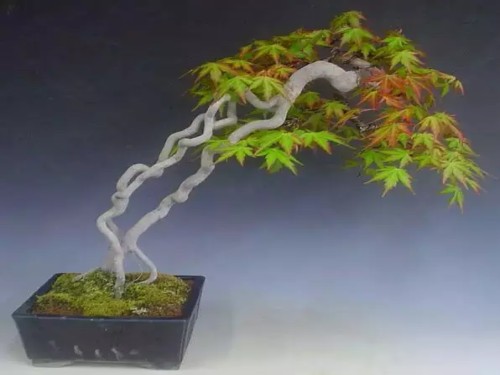The method of making bonsai after wood
Bonsai trees are dominated by safflower trees and white flowers. When the sun shines on the back of the leaves, the wonderful little world lights up immediately. The leaves of Ji Mu are like peach blossoms in spring, giving people vitality; they are as elegant and unrestrained as lotus flowers in summer; they are more exhilarating than sweet-scented osmanthus in autumn; but they are as attentive and unafraid of the cold as plum blossoms in winter.

It can be seen that the world of Ji Mu is a microcosm of nature, sometimes there is a feeling of birds approaching branches, and there is a tendency to move in the wind, just like a lifelike picture. The beauty of Ji Mu is self-evident, but after making it into a bonsai, it is another kind of beautiful enjoyment. So, how does Jimi make bonsai? The following editor will share the method of making bonsai to you!
First, draw materials
The pile scene can be obtained by artificial propagation such as sowing and cutting. Sowing needs to harvest ripe fruit in autumn, after drying, hang it in a dry and ventilated place, wait until the early spring of the next year, and sow in the early spring of the second year; cuttings should be carried out in the plum rain season, select about 15 cm in length of semi-lignified sturdy branches as cuttings, insert into the culture soil and water thoroughly, usually pay attention to the soil.
In addition, if you want to use the old pile to make bonsai, you can use the method of field excavation to obtain pile material. You can choose the old pile which has been cut down many times and has a strange appearance to be excavated in March. When digging, in addition to the need to protect the roots, it is recommended to attach moss to moisturize and transport it back in time for cultivation. During the cultivation period, in order to ensure the survival rate, the management work must be done well.
2. Upper basin
The operation of the next tree is roughly the same as that of other tree species, but we need to pay attention to some details, but these details may be the key to the success of bonsai production, so we need to take it seriously.
1. Selection of basin
The flowerpots suitable for potted trees can choose purple sand pottery pots or glazed pottery pots. The shape of the pots needs to be determined according to the shape of the tree, preferably with a deeper rectangle or oval shape. In the color of the basin, in order to highlight the characteristics of luxuriant branches and leaves, we can choose purple or light yellow to set it off.
2. Distribution of soil
Sequel is not very strict in terms of soil environment, because although it also likes loose and fertile partial acid loam, it is more resistant to barren. As a pot production bonsai management can use mature garden soil, rotten leaf soil + sandy soil, rice chaff ash can be used.
3. Planting
Muxia mountain piles can usually be carried out before sprouting in spring. Excessively long roots, especially redundant roots with intertwined roots, need to be cut off when planting. But when trimming the root, you need to make the cut smooth and without frustration, and then smear some disinfectants to prevent the root wound from mildew, which is more conducive to growth. If the basin is very deep, you can pad some broken tiles on the bottom of the basin and then cover it with a layer of coarse sand, which is more conducive to drainage. Then put the trimmed downhill pile vertically into the basin, and then put it on the basin according to the planting method of other tree species.
Third, modeling
When we choose the successor wood, the downhill pile already has a certain modeling effect, but in order to achieve a perfect artistic display, we also need to carry out manual modeling processing.
1) processing
The second tree is a kind of plant that is more resistant to pruning, so pruning is often used in its processing and modeling, followed by climbing. Pruning can be carried out according to your own design ideas and tree shape, while climbing can be done with metal wire, which is more convenient to control than brown wire. However, in order to prevent the wire from being trapped in the branch and affecting the ornamental effect of the plant growth, the wire should be removed in time when the climbing goal is reached.
When operating, you need to twist the branches according to their own design direction, and then cut off the overgrown branches and leaves up and down, and only need to keep the side branches. Wait until the new branches and buds sprout, and then use this method to make the posture of the tree more abundant. Of course, modeling processing can only be trimmed, without climbing techniques, but pruning requires long-term hard cutting and can not leave too many man-made traces, as far as possible to make the bonsai show a natural state, so that it will be ornamental and artistic.
2. Tree shape
Successor trees, like most tree species, can be made into oblique dry type, curved dry type, withered peak type, horizontal dry type, cliff type and other display forms. In the pruning of branches and leaves, you can keep them in the shape of semicircular clouds. Of course, the design ideas of each creator are different, so the modeling and embodiment forms are different, but a principle to be grasped is to make the tree shape appear in front of the world in a more natural way as much as possible.
The above are the technical points of making wood bonsai. After completion, the next work is the daily maintenance and management. In terms of maintenance and management, in addition to the daily water and fertilizer management, the most frequently used way is pruning. In order to keep a good posture of bonsai to show you, we must work hard on pruning. The editor will not elaborate here. Please refer to the relevant articles.
Time: 2019-05-25 Click:
- Prev

Cultivation techniques of Chinese wolfberry potted landscape
Lycium barbarum stump bonsai posture elegant, hanging branches, purple flowers and red fruits, is a plant of great ornamental value. But to turn ordinary wolfberry into bonsai requires a long period of careful cultivation by bonsai artists, but one thing is certain.
- Next

How to lift the root of bonsai
The root is an important part of the stump bonsai. The distribution and shape of the root directly affect the ornamental value of the bonsai. Through planned cultivation, the roots of the stump are turned over, changed soil and changed pots year by year. In this process, the roots are arranged, the extension direction of the roots is mastered, and then they continue to be planted, gradually revealing the soil surface of the roots.
Related
- Fuxing push coffee new agricultural production and marketing class: lack of small-scale processing plants
- Jujube rice field leisure farm deep ploughing Yilan for five years to create a space for organic food and play
- Nongyu Farm-A trial of organic papaya for brave women with advanced technology
- Four points for attention in the prevention and control of diseases and insect pests of edible fungi
- How to add nutrient solution to Edible Fungi
- Is there any good way to control edible fungus mites?
- Open Inoculation Technology of Edible Fungi
- Is there any clever way to use fertilizer for edible fungus in winter?
- What agents are used to kill the pathogens of edible fungi in the mushroom shed?
- Rapid drying of Edible Fungi

